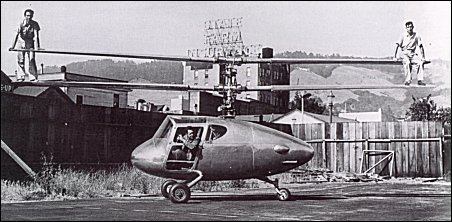
| Hiller X-2-235 1959 |  |
 |

| Hiller X-2-235 1959 |  |
 |
|
Work had begun in October 1944 on three Hiller X-2-235's, two-place metal-clad successors to the XH-44, each powered by a 235hp Lycoming engine. Whereas the XH-44 was the world's first successful rigid-rotor helicopter, the X-2-235 featured super-rigid rotors. This unprecedented degree of rigidity was provided to ensure that the opposite-turning rotors would never touch during even the most violent maneuvering. As built, in fact, the blades could support a person standing at the tip without noticeable deflection. Ground tests of the first example began in the summer of 1945 at the Old Berkeley Armory. Although no specific military requirement yet existed for such a machine, the X-2-235 was intended primarily for U.S. Navy use in the light utility, observation, and training roles. The Navy did not actually order the type, but it did procure the third uncompleted X-2-235 under the designation UH-1X, for evaluation in NACA wind tunnels at Langley Field, Virginia. Vibration problems curtailed these tests for fear of damaging the wind tunnel, but not before results vindicated the Hiller group's belief that super-rigid coaxial rotors were a valid approach to very highspeed helicopter flight. The UH-1X, Hiller's first military contract, clearly ran counter to normal aircraft engineering, but then the team building it had experience only in designing ships, bridges, and similar beefy structures. The lack of even a single aeronautical engineer on Hiller's payroll to introduce that field's antipathy to heavy structures was, ironically, an advantage in the uncharted terrain being explored. As a result of the NACA tests, Hiller initiated redesign of the X-2-235 to incorporate three-bladed coaxial rotors augmented by an aft-thrusting rear propeller. The reworked craft was obviously geared to flight at speeds substantially higher than those attained by existing helicopters. Main wheels retracting into sleek wing stubs further confirmed this supposition. Meanwhile, the X-2-235s themselves had now progressed to tethered flight. J.P.Spencer "Whirlybirds: A History of the U.S. Helicopter Pioneers", 1998
|